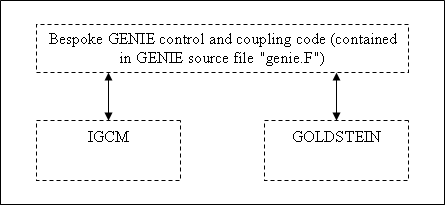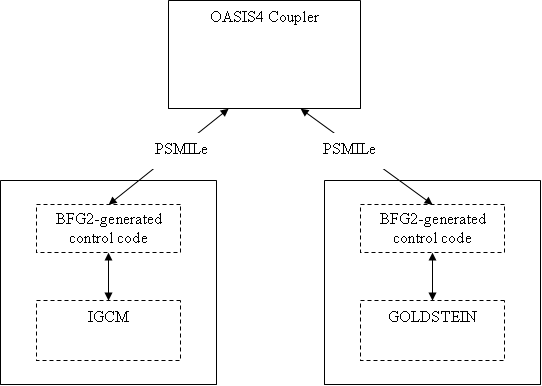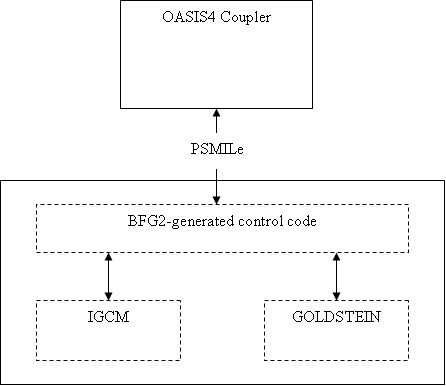GENIE Coupling
Ian Henderson (I.R.Henderson@reading.ac.uk)
Coupling Introduction
Coupling, the controlled passing of scientific variables (sometimes known as "fields" or "transients") between models, is currently achieved using bespoke code within the GENIE framework. A very basic illustration of this is given in Figure 1 (below):
Figure 1: GENIE framework showing IGCM and GOLDSTEIN components coupled internally using bespoke code (genie.F)
The GENIE community requires a more general and flexible coupling approach for the following reasons:
- It will be easier for modellers to couple new models and revised implementations of existing GENIE models (for instance, operating at new resolutions) if a standard coupling interface is used. In future, modellers will only need to provide coupling meta-data (perhaps via a GUI) -- specifying what fields are to be coupled on what grids -- without having to write bespoke code to implement the coupling itself.
- GENIE runs may be performed more quickly by harnessing the parallel execution facilities provided by a general coupler to run models simultaneously
- Alternative methods of spatial interpolation for translating variables between different model grids may be used without the addition of more bespoke code to GENIE. Sensitivity of the GENIE framework to different methods of interpolation -- for instance nearest-neighbour, bilinear, or bicubic -- can be investigated and assessed.
The GENIE earth system modelling framework will incorporate the Program for Integrated Earth System Modelling (PRISM) coupler, OASIS. The OASIS coupler is part of the PRISM community standard tool set for earth system models, and will enable the coupling of full complexity models in future. The "glue code" holding the framework together will be generated by the Bespoke Framework Generator (BFG). BFG will help insulate GENIE models from changes in OASIS (or allow the use of a different coupler in future).
What will be coupled and how?
This section outlines which GENIE models will be coupled, and provides more detail about how the coupling will be achieved.
IGCM and GOLDSTEIN
The GENIE team would initially like to couple the IGCM atmosphere and GOLDSTEIN ocean models (with slab sea-ice). By coupling two models that are already coupled within the GENIE framework, it will be possible to compare directly the results and performance of OASIS coupling with that for the bespoke coupling currently used in GENIE (largely implmented in Genie.F). In addition, IGCM and GOLDSTEIN use different spatial grids: long/lat for IGCM, and equal area for GOLDSTEIN. The use of different grids will allow investigation and comparison of the different interpolation algorithms provided by OASIS (nearest neighbour, bilinear, and bicubic). IGCM and GOLDSTEIN resolutions of 64x32x7 (T21) and 72x72x16 ("High") will be used to begin with.
OASIS4
The GENIE coupling project will use the latest version of the OASIS coupler, OASIS4. OASIS4 is a significant rewrite of the previous PRISM release, OASIS3. OASIS4 is currently at a beta release stage (functionally complete, but not stable). The GENIE coupling project will use OASIS4 for the following reasons:
- OASIS4 supports 3D field passing in addition to the 2D field passing supported by OASIS3. If we want to implement OASIS coupling for all GENIE model combinations, we will need OASIS4 because GOLDSTEIN-BIOGEM coupling passes 3D fields (as would future atmospheric chemistry).
- The significant change in the user interfaces for OASIS3 and 4: OASIS4 uses a different structure and language (XML) for metadata, meaning a time-consuming and costly switch at a later date if OASIS3 is used now.
- The use of a pre-release version of OASIS will also allow us to provide feedback to PRISM, helping to improve the coupler and benefitting both PRISM and the GENIE project.
BFG2
The GENIE coupling project will use the latest version of the Bespoke Framework Generator (BFG), a prototype implementation of the University of Manchester's Flexible Coupling Approach (FCA). BFG will be used to generate the framework code that "stitches together" IGCM, GOLDSTEIN, and the OASIS coupler. The BFG2 prototype is much more suitable than the BFG1 prototype because:
- BFG2 supports multiple entry points to a model - for instance the calling of explicit "initialise" functions as well as a "timestep" function. (GOLDSTEIN and IGCM have separate initialise and timestep functions.)
- BFG2 supports models with an argument-passing interface. (In BFG1, the model's timestep function could not take any arguments, and fields therefore had to be passed between models via BFG put and get function calls.)
Example GENIE configurations
Figure 2 shows the IGCM and GOLDSTEIN components of GENIE deployed as two separate processes, coupled by the PRISM coupler OASIS (a third process). BFG-generated control code handles the initialisation, update (time-stepping) and termination of the GENIE component models. The control code also incorporates PSMILe (PRISM System Model Interface Library) grid-initialisation code generated from the Gridspec, and uses PSMILe to send and receive coupling fields to and from the OASIS coupler during the run.
Figure 2: OASIS coupling in GENIE showing IGCM and GOLDSTEIN components as separate processes, possibly running in parallel
Figure 3 shows the IGCM and GOLDSTEIN components of GENIE deployed as a single process. Compare Figures 2 and 3 with the native GENIE configuration shown in Figure 1: coupling is implemented as a separate process with control code generated by BFG.
Figure 3: OASIS coupling in GENIE showing IGCM and GOLDSTEIN components sharing the same process
Grids and Coupling
Most variables that need to be passed from one model to another are associated with various types and resolutions of geographic grid. Currently grid metadata (for instance type and size of grid) is embedded in the GENIE framework code itself, or included via GENIE-specific configuration files such as Fortran namelists. The OASIS coupler and BFG use metadata to represent coupling fields (or "transients"), but like the current GENIE framework code itself, there is currently no way to describe the geographic grids associated with the coupling fields. A central part of the GENIE coupling project is therefore to devise a suitable method for describing grid metadata that fulfils the following requirements:
- Can represent all GENIE model grid metadata required by the PRISM coupler, OASIS.
- Be suitable for processing by BFG, which will use the grid metadata in the automatic production of GENIE framework code. BFG requires sufficient grid metadata for creating PRISM grid initialisation subroutine calls, and for use in the creation of the PRISM SMIOC (Specific Model Input and Output Configuration). BFG will also use the grid metadata to initialise the GENIE models (e.g. create the "initialise_atmos" call to initialise IGCM with the resolution specified in the grid metadata).
- Is sufficiently general so that it can be extended to support grids used by models outside the GENIE framework. Particular attention should be paid to representing the grids used by the UK Met Office, in particular for their new Flexible Unified Model Environment (FLUME).
- Adopts a structure and format similar to the grid specification prototype currently being worked on by V. Balaji. Balaji's prototype gridspec was presented at the May 2006 metadata meeting, hosted by the Met Office.
Work plan
The following tasks comprise a relatively short-term work plan. This plan will be modified and extended as work progresses.
- Identify the metadata needed by OASIS for the GENIE models (physical interface, grids and interpolations, currently in genie.F). As part of this, an OASIS4 toy model will be written to determine what data is required to initialise OASIS with the grids used by IGCM and GOLDSTEIN. [Ian]
- Create a grid metadata description ("gridspec") based on Balaji's prototype, and suitable for describing the metadata required for IGCM and GOLDSTEIN (as determined above). The gridspec will be developed with input from the GENIE community, PRISM, the BFG developers (University of Manchester), the Met Office, NCAS-Climate (University of Reading), and Balaji. Development of the gridspec will be iterative, starting with an initial prototype that can be used to generate feedback from interested parties. [Ian to lead]
- Once an agreed gridspec has been developed, BFG will use it to create the appropriate PRISM grid initialisation calls, model initialisation calls, and PRISM metadata (SMIOC). The resulting BFG-generated version of the GENIE framework will be capable of running the prescribed models (IGCM atmosphere and GOLDSTEIN ocean) with grid coupling and interpolation. [Ian + BFG developers]
- The BFG-generated OASIS-coupled GENIE configurations will be tested and compared with "native" GENIE and BFG-generated MPI-coupled GENIE configurations. A report will be written describing the work carried out, including test results, analysis of OASIS coupler performance and interpolation, and recommendations for future development. [Ian]
Progress and visits
Tasks and timetable for GENIE-PRISM coupling project (Gantt chart PDF)
- GENIE working on Reading Met Dept Sun Solaris workstations
- IGCM 1.1 working on Reading Met Dept Condor pool
- Orientation visit to Manchester for briefing and demo of BFG (August 2006)
- OASIS 4.0.2 (August 2006) and OASIS 4 toy model working on Reading Linux workstation (ruby)
- GENIE grid prototype created and coupled with OASIS 4 (identical grids for atmosphere and ocean "stub" models)
- GENIE grid prototype converted to use the PRISM Standard Compile Environment (SCE)
- GENIE grid prototype working with IGCM and GOLDSTEIN grids at resolutions of 64x32x7 (T21) and 72x72x16 ("High")
- Visit to UK Met Office to discuss grid specification with respect to FLUME and NEMO (October 2006)
- GENIE grid prototype modified to illustrate both 2D and 3D grid configuration and coupling using IGCM and GOLDSTEIN grids
- Draft XML gridspec implementation available for circulation and comment
- BFG2 OASIS4 target added for "gridless" (non-geographic) grids
- BFG2 OASIS4 code generation implemented for geographic grids (coupling between components with identical geographic grids)
- BFG2 uses gridspec to carry out OASIS4 grid initialisation
- Grid points can be specified by providing an algorithm (e.g. a Fortran subroutine) referenced from the gridspec
- BFG2 OASIS4 code generation implemented for coupling fields with multiple sources or destinations
- BFG2 OASIS4 code generation implemented for coupling between non-identical geographic grids using "intrinsic transformations"
- BFG2 functionality added for components with multiple grids, both geographic and "gridless" (non-geographic)
- OASIS4 modified to support components with 100+ transients (coupling fields)
- BFG2 uses gridspec and FoX XML library to generate KML files of grid points for visualisation in Google Earth
- Full BFG2-GENIE ig_fi_sl config compiling and running with OASIS4 coupler
- BFG2 functionality added for profiling and visualisation (SVG) of OASIS4 communications (prism_put/get)
Last modified: 15:39, 8 February 2008 (UTC)


